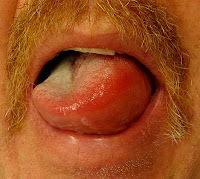Skin care > Skin diseases > Causes of cellulitis infection
Medical definitions of cellulitis
Wordnetweb.princeton.edu definition of cellulitis: "an inflammation of body tissue (especially that below the skin) characterized by fever and swelling and redness and pain".The medical-dictionary.thefreedictionary.com defines it as "cellulitis is a spreading bacterial infection just below the skin surface. It is most commonly caused by Streptococcus pyogenes or Staphylococcus aureus."
What causes cellulitis?
Skin is a semipermeable barrier protecting the inner layers and organs from microbial invasion. When there is damage to the skin due to injury, cut, surgical incision, burn, abrasion, insect bite, animal bite or scratch, there is the risk of the entry of bacteria into the inner tissues. Though our body's immune mechanism gears up to neutralize the invading organisms, in some circumstances the bacteria may persist and multiply in the tissues to cause cellulitis. These infections most often occurs on the face, eyes, neck, hands and legs.Organisms causing cellulitis:
- Streptococcus pyogenes,
- Staphylococcus aureus,
- Streptococcus pneumoniae,
- Hemophilus influenza type B,
- Pasteurella multocida,
- Staphylococcus intermedius,
- Aeromonas hydrophila,
- Vibrio vulnificus,
- Pseudomonas aeruginosa and
- Methicillin-resistant Staphylococcus aureus (MRSA).
Is cellulitis contagious?
The skin infections caused by the streptococcus and staphylococcus bacteria spread fast. The warmth, moisture and availability of the nutrients make these bacteria to multiply and grow rapidly. The release of the metabolic wastes, toxins and enzymes by the invading pyogenic microbes cause damage to surrounding tissues and lead to necrosis of the tissues.In the same patient cellulitis can become contagious. Any subsequent damage to a new area of the skin can cause fresh occurrences when the infection is not treated. Given the invasive nature of the disease, it can spread to deeper skin and cause necrotizing fasciitis. An untreated cellulitis can spread through lymph and cause lymphangitis and lymphadenitis. It can also spread through the bloodstream and cause bacteremia and affect the vital organs.
Cellulitis is not directly contagious. Sometimes it becomes contagious when the surgical instruments and equipments are not properly sterilized. However the bacteria can spread from the patient to others by direct contact with open sore and exudate. The exposed individual is in the high risk of contracting the disease if he has skin injury. Cellulitis is found to be contagious when the living space is crammed as in dormitories. Contagious community-acquired MRSA infections may spread rapidly among the occupants.
Types of cellulitis
Orbital cellulitis is a serious infection of the eye tissues usually spread by the paranasal sinuses. Staphylococcus aureus and Streptococcus pneumoniae are the primary culprit organisms. It requires emergency treatment as the infection can cause blindness and affect the brain. It can also occur from the eyelid infection, upper respiratory disease, sinusitis, eye injury, bacteremia and dental procedures. Sinusitis caused by Haemophilus influenzae type B can sometime end up in orbital cellulitis. Surgery and incisions, especially on the face can cause these infections if required antibiotic regimen is not followed.Periorbital cellulitis ( aka preseptal cellulitis) is a less serious infection affecting the eyelids. The infection from skin injury around the eye and eyelids is the cause. Animal bites can cause this condition due to the presence of Pasteurella multocida bacteria in animal saliva. When skin lacerations and wounds are sustained in fresh water, Aeromonas hydrophila bacteria can enter the wound and cause severe suppurating cellulitis infections.
What are the risk factors of contracting cellulitis infections
- Person with chronic strep throat may cough up small specks phlegm with high load of Streptococcus pyogenes bacteria. Persons having open skin injuries when come into contact with these droplets of phlegm can develop the disease.
- Patients with cancer, HIV, diabetes or renal disease have the high risk of contracting the infection.
- Prolonged use of corticosteroid medications and immunosuppressants can put a person at risk for developing the disease.
- Reduced blood circulation to the limbs as in chronic venous insufficiency, varicose veins and poliomyelitis can put a person at the risk of developing cellulitis.
- Chronic skin disorders like eczema, dermatitis, herpes infection, athlete's foot and chickenpox can provide entry points for the bacteria and increase the risk of this condition.
- Persons taking insulin injections, alcoholics and intravenous drug abusers are among the high risk group.
- Diabetics with diabetic foot/foot ulcers have the high risk of developing the bacteria.
- Diabetics with poor control of blood glucose levels are in the risk of developing the condition as high levels of glucose helps in rapid development of bacteria.
Popular topics on skin care:
Stratum granulosum.
Function of hypodermis.
Papillary dermis.
Rhinophyma treatment.
Homemade skin treatments.
Structure of dermis.
Stratum corneum.
Hives and angioedema.
Stratum basale.
Stratum spinosum.
Stratum granulosum.
Function of hypodermis.
Papillary dermis.
Rhinophyma treatment.
Homemade skin treatments.
Structure of dermis.
Stratum corneum.
Hives and angioedema.
Stratum basale.
Stratum spinosum.
Author: RafaelLopez | Lisense: CC BY-SA 3.0
References
1.Swartz MN. Clinical practice: cellulitis. N Engl J Med. 2004;350:904-912.
2.Lin Y-TJ, Lu P-W (2006). Retrospective study of pediatric facial cellulitis of odontogenic origin. Pediatric Infectious Disease Journal, 25(4): 339-342.
Current topic in "the dynamic nature skin care": Definition of cellulitis - Causes of cellulitis infection.

